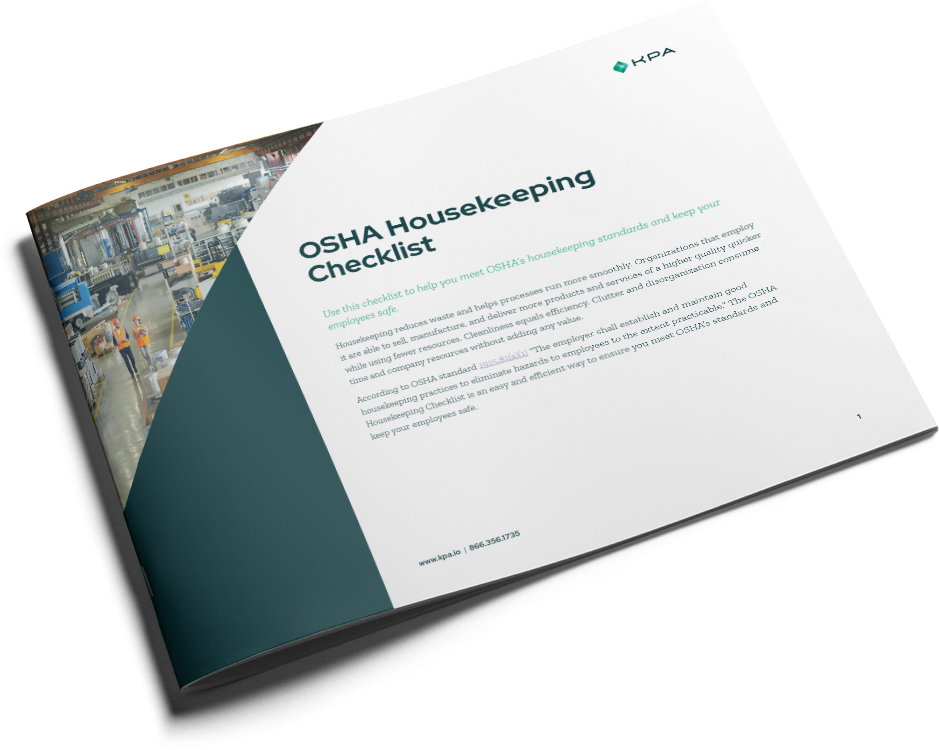Get excited: it’s housekeeping time!
Okay, I know most people aren’t thrilled about the prospect of cleaning and organizing their stuff. If you’re like me, you put off taking care of messes until they’re impossible to ignore. Then you enter a state of pure frenzy and panic, feverishly deep-cleaning everything you own (and throwing out about half of it) until your house looks more pristine than the day it was built. And then you wipe your forehead, crack open a beer (or eat a cookie), and vow to never let it become that bad ever again.
Cut to a year later… and, well, you can probably guess what happens.
This is a common cycle, and not just in terms of one’s home. Many organizations out there are in desperate need of housekeeping. Their facilities are cluttered, dirty, and disorganized. Their key workforce safety and compliance documents are spread across various locations, stuffed in binders, hidden in random drawers, or all of the above.
As a result, these organizations create unnecessary hazards for their workers—as well as major headaches for executives if the Occupational Health and Safety Administration comes to visit.
Good workplace housekeeping can help your organization in multiple ways. It can save you tens of thousands, hundreds of thousands, or even millions of dollars annually. Over the next few weeks here on the blog, we’ll be exploring the fundamentals of organizational housekeeping, including…
- why workplace housekeeping is important,
- the 5 “S Principles” and how they can help your workplace,
- how to motivate your team to spruce things up,
and - why clean work environments go hand-in-hand with safety.
Use this as an opportunity to start cleaning your own space. Whether you’re reading this during spring cleaning season or sometime later, right now—whenever now is—is the perfect time to get to work.
Let’s start with the importance of good workplace housekeeping.
4 Reasons Housekeeping Matters

Download KPA's OSHA Housekeeping Checklist to help you identify areas in need of some good housekeeping.
But There’s Another Reason Workplace Housekeeping Is So Important…
…and it’s a big reason.
Cleanliness is an OSHA requirement.
The Occupational Safety and Health Act’s General Duty Clause states that each employer (emphasis added) “shall furnish to each of his employees employment and a place of employment which are free from recognized hazards that are causing or are likely to cause death or serious physical harm to employees,” and “shall comply with occupational safety and health standards promulgated under this Act.”
On top of that, OSHA requires that every employee “comply with occupational safety and health standards and all rules, regulations, and orders issued pursuant to this Act which are applicable to his own actions and conduct.”
In other words, employers and their employees are responsible for keeping people safe. That includes mopping up spills, sanitizing surfaces, removing clutter from work areas, disposing of waste, ensuring aisles and exit paths are clear, and so forth.
Keep in mind that first impressions matter to OSHA inspectors, too. A messy environment is a serious indication of health and safety issues. If an inspector walks into a dirty or disorganized facility, they’ll look even more closely for violations than they would otherwise—and they’re likelier to find them.
In our next article, we’ll roll up our sleeves and get into what good housekeeping looks like through the 5 S Principles: Sort, Set in Order, Shine, Standardize, and Sustain.
Don’t wait until then to start cleaning and improving your organization’s housekeeping. KPA’s workforce safety and compliance team can help—contact us.
Related Content
Explore more comprehensive articles, specialized guides, and insightful interviews selected, offering fresh insights, data-driven analysis, and expert perspectives.